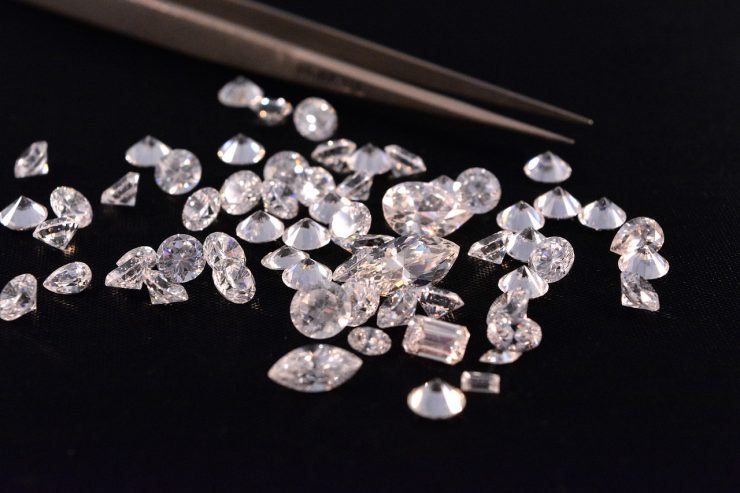
Diamonds have long been cherished for their beauty and rarity, serving as symbols of love, status, and wealth. Traditionally, diamonds are extracted from the Earth through mining, a process that has significant environmental implications. However, advances in technology have given rise to lab-made, or synthetic, diamonds, which are produced in controlled environments. This article compares the environmental footprint of lab-made diamonds with that of mined natural diamonds, focusing on water usage, emissions, land disruption, and energy consumption.
Water Usage
Mined Natural Diamonds
The extraction of natural diamonds is a water-intensive process. Diamond mining operations require substantial amounts of water for various stages, including ore processing, dust suppression, and cooling of machinery. For example, open-pit and underground mining methods both demand large volumes of water to separate diamonds from the ore and to manage waste. The use of water in mining often leads to significant environmental impacts, such as the depletion of local water resources and contamination of water bodies with mining byproducts and chemicals used in ore processing.
Lab-Made Diamonds
In contrast, the production of lab-made diamonds generally uses significantly less water. There are two main methods for creating synthetic diamonds: High Pressure High Temperature (HPHT) and Chemical Vapor Deposition (CVD). Both methods require water for cooling and other processes, but the volumes are considerably lower compared to traditional mining. The reduced water usage in lab-grown diamond production is a key environmental advantage, as it alleviates pressure on freshwater resources and minimizes the risk of water pollution.
Emissions
Mined Natural Diamonds
Diamond mining is associated with substantial greenhouse gas (GHG) emissions. The extraction and processing of diamonds involve the use of heavy machinery and explosives, which release carbon dioxide (CO2) and other pollutants into the atmosphere. Additionally, the transportation of diamonds from remote mining sites to processing facilities and markets further contributes to the carbon footprint. Emissions from diamond mining not only exacerbate climate change but also degrade air quality, posing health risks to local communities and wildlife.
Lab-Made Diamonds
Lab-made diamonds have a smaller carbon footprint compared to mined diamonds. The HPHT and CVD processes do consume energy, but advancements in technology and the use of renewable energy sources have significantly reduced their emissions. For instance, some synthetic diamond manufacturers have transitioned to using solar or wind power, further lowering their GHG emissions. Despite the energy requirements, the overall emissions from lab-grown diamonds are substantially less than those from mining operations, making them a more environmentally friendly option.
Land Disruption
Mined Natural Diamonds
One of the most significant environmental impacts of diamond mining is land disruption. Open-pit mining, the most common method, involves removing vast amounts of soil and rock to access diamond-bearing ore. This process results in large-scale deforestation, habitat destruction, and soil erosion. In addition, abandoned mines often become hazardous waste sites, posing long-term environmental and safety risks. The disruption of ecosystems and loss of biodiversity are critical concerns associated with diamond mining.
Lab-Made Diamonds
Lab-made diamonds, produced in controlled laboratory environments, do not require land excavation or deforestation. The manufacturing facilities for synthetic diamonds have a much smaller physical footprint compared to open-pit mines. As a result, the production of lab-grown diamonds has minimal impact on land and ecosystems. This significant reduction in land disruption is a major environmental benefit, contributing to the preservation of natural habitats and biodiversity.
Energy Consumption
Mined Natural Diamonds
The energy consumption of diamond mining is substantial, encompassing the use of fossil fuels to power heavy machinery, processing plants, and transportation vehicles. Mining operations are energy-intensive, with significant amounts of diesel, gasoline, and electricity required to extract and process diamonds. The reliance on non-renewable energy sources contributes to the overall environmental impact of diamond mining, including GHG emissions and resource depletion.
Lab-Made Diamonds
The production of lab-made diamonds also requires energy, primarily for maintaining high temperatures and pressures in HPHT processes or creating plasma in CVD processes. However, the energy consumption is generally lower than that of traditional mining. Moreover, the use of renewable energy sources, such as solar and wind power, by some synthetic diamond producers further reduces the environmental impact. As technology continues to advance, the energy efficiency of lab-grown diamond production is expected to improve, making it an even more sustainable alternative.
Conclusion
The production of lab-made diamonds offers several environmental benefits compared to traditional diamond mining, including reduced water usage, lower emissions, minimal land disruption, and potentially lower energy consumption. Additionally, lab-grown diamonds address many ethical and social concerns associated with natural diamond mining, such as conflict diamonds and poor working conditions. However, both production methods have their own set of challenges and impacts that need to be managed.
As the diamond industry evolves, it is crucial to continue improving the sustainability and ethics of both lab-made and natural diamond production. Consumers, manufacturers, and policymakers all have a role to play in promoting responsible practices and supporting innovations that reduce the environmental and social footprint of diamonds. By making informed choices and advocating for sustainable development, we can ensure a more ethical and environmentally friendly future for the diamond industry.